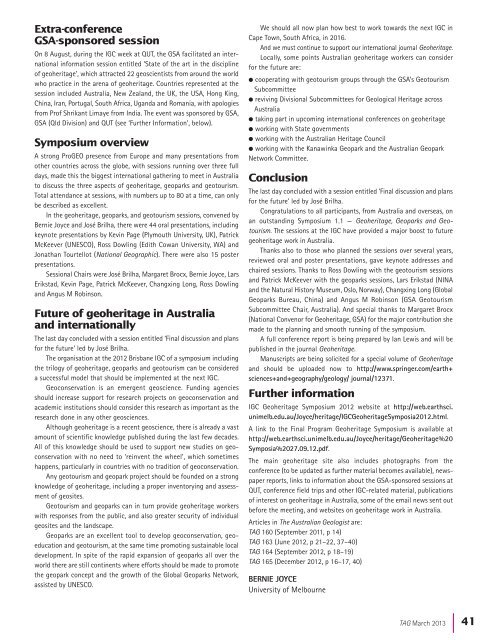TAG 166 - Geological Society of Australia
TAG 166 - Geological Society of Australia
TAG 166 - Geological Society of Australia
You also want an ePaper? Increase the reach of your titles
YUMPU automatically turns print PDFs into web optimized ePapers that Google loves.
Extra-conferenceGSA-sponsored sessionOn 8 August, during the IGC week at QUT, the GSA facilitated an internationalinformation session entitled ‘State <strong>of</strong> the art in the discipline<strong>of</strong> geoheritage’, which attracted 22 geoscientists from around the worldwho practice in the arena <strong>of</strong> geoheritage. Countries represented at thesession included <strong>Australia</strong>, New Zealand, the UK, the USA, Hong King,China, Iran, Portugal, South Africa, Uganda and Romania, with apologiesfrom Pr<strong>of</strong> Shrikant Limaye from India. The event was sponsored by GSA,GSA (Qld Division) and QUT (see ‘Further Information’, below).Symposium overviewA strong ProGEO presence from Europe and many presentations fromother countries across the globe, with sessions running over three fulldays, made this the biggest international gathering to meet in <strong>Australia</strong>to discuss the three aspects <strong>of</strong> geoheritage, geoparks and geotourism.Total attendance at sessions, with numbers up to 80 at a time, can onlybe described as excellent.In the geoheritage, geoparks, and geotourism sessions, convened byBernie Joyce and José Brilha, there were 44 oral presentations, includingkeynote presentations by Kevin Page (Plymouth University, UK), PatrickMcKeever (UNESCO), Ross Dowling (Edith Cowan University, WA) andJonathan Tourtellot (National Geographic). There were also 15 posterpresentations.Sessional Chairs were José Brilha, Margaret Brocx, Bernie Joyce, LarsErikstad, Kevin Page, Patrick McKeever, Changxing Long, Ross Dowlingand Angus M Robinson.Future <strong>of</strong> geoheritage in <strong>Australia</strong>and internationallyThe last day concluded with a session entitled ‘Final discussion and plansfor the future’ led by José Brilha.The organisation at the 2012 Brisbane IGC <strong>of</strong> a symposium includingthe trilogy <strong>of</strong> geoheritage, geoparks and geotourism can be considereda successful model that should be implemented at the next IGC.Geoconservation is an emergent geoscience. Funding agenciesshould increase support for research projects on geoconservation andacademic institutions should consider this research as important as theresearch done in any other geosciences.Although geoheritage is a recent geoscience, there is already a vastamount <strong>of</strong> scientific knowledge published during the last few decades.All <strong>of</strong> this knowledge should be used to support new studies on geoconservationwith no need to ‘reinvent the wheel’, which sometimeshappens, particularly in countries with no tradition <strong>of</strong> geoconservation.Any geotourism and geopark project should be founded on a strongknowledge <strong>of</strong> geoheritage, including a proper inventorying and assessment<strong>of</strong> geosites.Geotourism and geoparks can in turn provide geoheritage workerswith responses from the public, and also greater security <strong>of</strong> individualgeosites and the landscape.Geoparks are an excellent tool to develop geoconservation, geoeducationand geotourism, at the same time promoting sustainable localdevelopment. In spite <strong>of</strong> the rapid expansion <strong>of</strong> geoparks all over theworld there are still continents where efforts should be made to promotethe geopark concept and the growth <strong>of</strong> the Global Geoparks Network,assisted by UNESCO.We should all now plan how best to work towards the next IGC inCape Town, South Africa, in 2016.And we must continue to support our international journal Geoheritage.Locally, some points <strong>Australia</strong>n geoheritage workers can considerfor the future are:l cooperating with geotourism groups through the GSA’s GeotourismSubcommitteel reviving Divisional Subcommittees for <strong>Geological</strong> Heritage across<strong>Australia</strong>l taking part in upcoming international conferences on geoheritagel working with State governmentsl working with the <strong>Australia</strong>n Heritage Councill working with the Kanawinka Geopark and the <strong>Australia</strong>n GeoparkNetwork Committee.ConclusionThe last day concluded with a session entitled ‘Final discussion and plansfor the future’ led by José Brilha.Congratulations to all participants, from <strong>Australia</strong> and overseas, onan outstanding Symposium 1.1 — Geoheritage, Geoparks and Geotourism.The sessions at the IGC have provided a major boost to futuregeoheritage work in <strong>Australia</strong>.Thanks also to those who planned the sessions over several years,reviewed oral and poster presentations, gave keynote addresses andchaired sessions. Thanks to Ross Dowling with the geotourism sessionsand Patrick McKeever with the geoparks sessions, Lars Erikstad (NINAand the Natural History Museum, Oslo, Norway), Changxing Long (GlobalGeoparks Bureau, China) and Angus M Robinson (GSA GeotourismSubcommittee Chair, <strong>Australia</strong>). And special thanks to Margaret Brocx(National Convenor for Geoheritage, GSA) for the major contribution shemade to the planning and smooth running <strong>of</strong> the symposium.A full conference report is being prepared by Ian Lewis and will bepublished in the journal Geoheritage.Manuscripts are being solicited for a special volume <strong>of</strong> Geoheritageand should be uploaded now to http://www.springer.com/earth+sciences+and+geography/geology/ journal/12371.Further informationIGC Geoheritage Symposium 2012 website at http://web.earthsci.unimelb.edu.au/Joyce/heritage/IGCGeoheritageSymposia2012.html.A link to the Final Program Geoheritage Symposium is available athttp://web.earthsci.unimelb.edu.au/Joyce/heritage/Geoheritage%20Symposia%2027.09.12.pdf.The main geoheritage site also includes photographs from theconference (to be updated as further material becomes available), newspaperreports, links to information about the GSA-sponsored sessions atQUT, conference field trips and other IGC-related material, publications<strong>of</strong> interest on geoheritage in <strong>Australia</strong>, some <strong>of</strong> the email news sent outbefore the meeting, and websites on geoheritage work in <strong>Australia</strong>.Articles in The <strong>Australia</strong>n Geologist are:<strong>TAG</strong> 160 (September 2011, p 14)<strong>TAG</strong> 163 (June 2012, p 21–22, 37–40)<strong>TAG</strong> 164 (September 2012, p 18–19)<strong>TAG</strong> 165 (December 2012, p 16–17, 40)BERNIE JOYCEUniversity <strong>of</strong> Melbourne<strong>TAG</strong> March 2013| 41
















